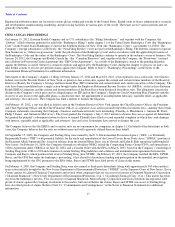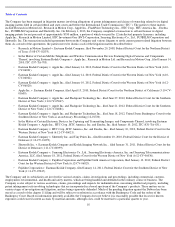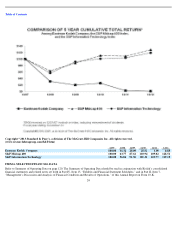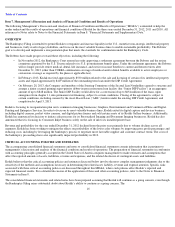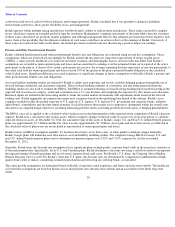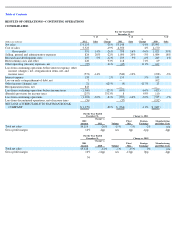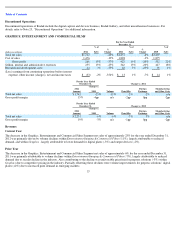Kodak 2012 Annual Report Download - page 30
Download and view the complete annual report
Please find page 30 of the 2012 Kodak annual report below. You can navigate through the pages in the report by either clicking on the pages listed below, or by using the keyword search tool below to find specific information within the annual report.
Table of Contents
Kodak estimates the fair value of its reporting units using an income approach and a market approach. To estimate fair value utilizing the market
approach, Kodak applies valuation multiples, derived from the operating data of publicly-traded benchmark companies, to the same operating
data of the reporting units. The valuation multiples are based on a combination of the last twelve months (“LTM”) financial measures of
revenue, earnings before interest, taxes, depreciation and amortization (“EBITDA”) and earnings before interest and taxes (“EBIT”).
Prior to 2011, the use of each of the income and market approaches provided corroboration for each other and Kodak believed each methodology
provided equally valuable information. For the 2011 annual goodwill test, the market approach was not utilized because reporting unit LTM
EBIT and EBITDA results were negative, which would have only allowed the application of a revenue multiple in determining fair value under
the market approach, and/or reporting units ranked below all the selected market participants for these financial measures. When using the
market approach, multiples should be derived from companies that exhibit a high degree of comparability to the business being valued.
For the 2012 annual goodwill test for all reporting units except for Document Imaging, Entertainment Imaging and Commercial Films and the
Graphics reporting units, Kodak did not utilize the market approach due to LTM EBIT and EBITDA results being negative. Kodak ultimately
gave 100% weighting to the income approach for the Entertainment Imaging and Commercial Films and Graphics reporting units due to the
declining projections for these reporting units. Kodak determined fair value of the Document Imagining reporting unit using 50% weighting of
the income and market approach.
To estimate fair value utilizing the income approach, Kodak establishes an estimate of future cash flows for each reporting unit and discounts
those estimated future cash flows to present value. The discount rates are estimated based on an after-tax weighted average cost of capital
(“WACC”) for each reporting unit reflecting the rate of return that would be expected by a market participant. The WACC also takes into
consideration a company specific risk premium for each reporting unit reflecting the risk associated with the overall uncertainty of the financial
projections. Key assumptions used in the income approach for the September 30, 2012 goodwill impairment tests, except for the Intellectual
Property reporting unit, were: (a) expected cash flows for the period ranging from October 1, 2012 to December 31, 2019; and (b) discount rates
of 22% to 28%, which were based on Kodak’s best estimates of the after-tax weighted-average cost of capital of each reporting unit.
A terminal value is included for all reporting units, except for the Intellectual Property and Consumer Inkjet Systems reporting units, at the end
of the cash flow projection period to reflect the remaining value that the reporting unit is expected to generate. The terminal value is calculated
using the constant growth method (“CGM”) based on the cash flows of the final year of the discrete period. If significant growth is projected in
the final year of the cash flow projection period, then the CGM is not applied to that year. Rather, the projection period is extended until the
growth in the final year approaches a sustainable level. The expected cash flow forecasts for Digital Printing, Packaging and Functional Printing,
and Enterprise Services and Solutions were extended by two years due to the rate of growth in the projections toward the end of the projection
period. For all other reporting units, the number of periods utilized in the cash flow model for the 2012 goodwill impairment test was the same as
the number used in the 2011 goodwill valuation (5+ years).
The Intellectual Property reporting unit includes licensing activities related to Kodak’s intellectual property (“IP”) in digital imaging products
and certain branded licensed products. In August 2012, the Bankruptcy Court approved the Company’s motion of bidding procedures to auction
its digital imaging patent portfolios. In September 2012, the Company filed a motion with the Bankruptcy Court to adjourn the sale of its digital
imaging patent portfolios until further notice. As of September 30, 2012, the Company continued to explore strategic alternatives while the
auction process continued, including licensing transactions, or retaining the patent portfolio and creating a newly formed licensing company as a
source of recovery for creditors in the reorganization plan. In order to estimate the fair value of the Intellectual Property reporting unit, Kodak
developed estimates of future cash flows both assuming a sale of the digital imaging patent portfolios (the “IP-Sale Scenario”) and assuming no
sale of the digital imaging patent portfolios but the continuation of the patent licensing program over the remaining life of the patent portfolio as
a newly formed licensing company (the “No-IP Sale Scenario”). For purposes of the goodwill valuation, the IP-Sale Scenario and the No-
IP Sale
Scenario were weighted equally in estimating the fair value of the Intellectual Property reporting unit. A discount rate of 45% was utilized to
discount the estimated future cash flows to present value.
On September 28, 2012, Kodak announced a plan, starting in 2013, to focus its Consumer Inkjet business solely on the sale of ink to its installed
printer. For purposes of the goodwill valuation, Kodak did not include a terminal value at the end of the cash flow projection period for the
Consumer Inkjet reporting unit.
Based upon the results of Kodak’s September 30, 2012 analysis, no impairment of goodwill was indicated.
On February 1, 2013, Kodak sold its digital imaging patents. The cash flows related to the Intellectual Property reporting unit from patent
licensing activity will significantly change and the fair value may be materially impacted as a result of the sale. The goodwill assigned to the
Intellectual Property reporting unit as of December 31, 2012 approximated $113 million.
27


